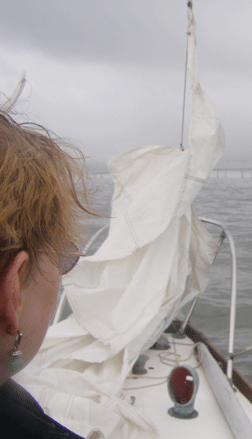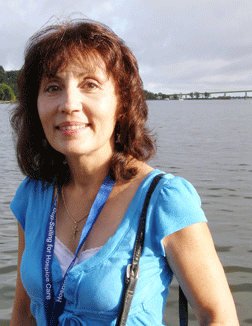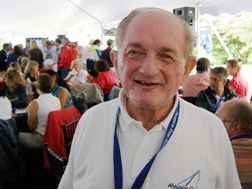|
Despite Listless Winds, Hospice Cup Fills Its Sails with Support In work like this, a little weather never gets in the way of successby Dotty Holcomb Doherty
Jibs lay quiet, and close-hauled mainsails hung listlessly ornamental as drenching rain and absent wind canceled this year’s 27th annual Hospice Cup race. After milling around starting areas for two hours, sailors in 89 boats — including 20 carrying hospice caregivers — motored home. The day’s success was measured not in races won but in money raised. For four area hospices, the day was pure sunshine. Sailing for CompassionThe Hospice Cup, one of 27 nationwide hospice regattas, raises money through sailor sponsorships, an after-race shore party — damp this year, under tents at Atria Manresa on the Severn River — and auctions. For all the rain, this year’s regatta contributed $350,000 to support Hospice of the Chesapeake, Montgomery Hospice, Capital Hospice and Community Hospices. The funds are much needed. “Hospice of the Chesapeake has an unbroken record of service as a non-profit provider of physical, emotional, psychosocial and spiritual care to the community,” says CEO Erwin Abrams, a jaunty man with a ready smile. “Medicare and private insurance do not cover our costs, resulting in the need to raise about 20 percent of our revenue. The Hospice Cup and other contributions enable us to keep our promise to the communities we serve.” Hospice care comes to patients, and their families, with a death sentence: less than six months of life. Bereavement support for sudden deaths is another part of hospice. Yet the people who do its work insist that hospice is less about death than about life. “Hospice is about living a better life,” said Elaine Tiller, who in 1980 developed one of the earliest bereavement care programs and now works with Montgomery Hospice.
It Takes a Team“It’s truly an honor to work in hospice,” said Karen Bryant of Hospice of the Chesapeake, which serves Anne Arundel and Prince George’s counties. “And an honor to have people come out to support us.” She told me her story along the banks of the Severn at the shore party. “I have been doing hospice for 19 years,” Bryant recounted. “Before that, I was a nurse in hospital acute care. I had wonderful colleagues in the hospital, but in hospice, the teamwork is so strong between our social workers, nurses, home health aides, volunteers and pastor. We work like a team like I have never seen.” Each hospice player has a role. Chaplains help with questions, often of fairness and providence. Social workers work through financial concerns and give emotional and psychological support. Bereavement counselors ease grieving. Volunteers help with a little of everything.
“We have 600 volunteers,” Bryant explains. “They do the full gamut, from reiki — healing touch without the touch — to vigil volunteers who sit with a dying patient. They’ll sit for hours. It’s unbelievable.” Teens who need service projects have teamed up with Hospice of the Chesapeake in a program called Lifetime Chronicles. “We take a select group of teenagers, ones we screen and feel can handle it emotionally,” Bryant explains. After training, the students pair up with patients to record their life stories. They make a journal, with pictures. “Patients just love recounting their lives,” she says. Other hospice workers help fulfill patients’ dying wishes. One patient was concerned for her small daughter, who feared she would not remember her. Social workers and volunteers helped the young mother make videos and cards for upcoming birthdays and her daughter’s wedding. At each year’s event, the daughter will have a message from her mother.
Life Stories“People open up their lives to you,” Bryant said, explaining the intimacy hospice work can bring. “You become like part of the family. Patients share things that can be hard to tell their loved ones.” One such patient was a woman in her 40s. When she had only a week to live, the patient asked her mother, with whom she was very close, to leave the room. “I could see the hurt on her mom’s face,” says Bryant, “but she obliged and left.” In tears, the dying woman told Bryant she feared that “no one will remember me.” With permission, Bryant brought the two women together. “I couldn’t have orchestrated a more beautiful moment,” Bryant told me. “The mother held her daughter and said, ‘Baby, I love you and you will always be my baby. If God is calling you, and it’s your time to go, then I don’t want you down here suffering.’ She said she would never forget her. She gave her permission to die.” Hospice helps terminally ill patients die peaceably, with grace and dignity. “It may well mean patients will actually live longer, have their pain controlled and have the opportunity to complete life’s work,” Abrams said. Hospice of the Chesapeake: 410-987-2003; www.hospicechesapeake.org.
|
||||||||
|
|
||||||||
|
© COPYRIGHT 2008 by New Bay Enterprises, Inc. All rights reserved.
|





